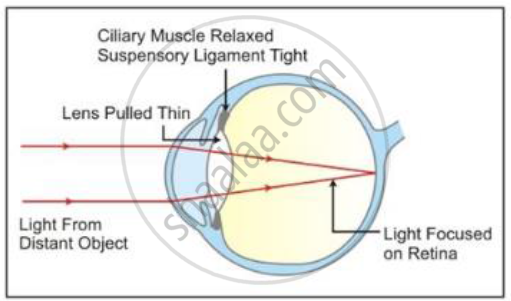Advertisements
Advertisements
प्रश्न
Describe the mechanism of focusing the image of a distant object in your eye when you raise your head after reading a book.
उत्तर १
While reading a book, the lens is more convex or rounded due to contraction of ciliary muscles because the book is usually read from a short distance. When we raise our head and look at a distant object, the ciliary muscles relax to build the tension on the suspensory ligament so that they can stretch the lens. This change in the curvature of the lens makes us focus on distant object.


उत्तर २
The lens is adjusted through accommodation to focus on a distant object while reading. This is a full description:
- Near Vision (Reading a Book):
- Reading causes ciliary muscle contractions in the eyes.
- When the ciliary muscles contract, the suspensory ligaments that support the lens slacken.
- This enables the lens to become more convex or rounded.
- Transition to Distant Vision (Raising Your Head):
- Your ciliary muscles relax when you elevate your head to focus on a distant object.
- Suspensory ligaments pull and flatten the lens.
- The ciliary muscles relax, and the suspensory ligaments strain on the lens.
- Accommodation Power of the Eye:
- Accommodation refers to the process of adjusting focus by modifying the lens shape.
- The eye's accommodation power relies heavily on the ciliary muscles.
- The eye's capacity to concentrate clearly at diverse distances is vital for adapting to various visual tasks.
The ciliary muscles alter the lens shape dynamically, making it convex for near vision and flat for distant vision. The eye's ability to focus clearly at varied distances is due to the process of accommodation.
APPEARS IN
संबंधित प्रश्न
Millions of people in the developing countries of the world are suffering from corneal blindness. These persons can be cured by replacing the defective cornea with the cornea of a donated eye. A charitable society of your city has organised a campaign in your neighbourhood in order to create awareness about this fact. If you are asked to participate in this mission, how would you contribute in this noble cause?
(i) State the objective of organising such campaigns.
(ii) List two arguments which you would give to motivate the people to donate their eyes after death.
(iii) List two values which are developed in the persons who actively participate and contribute in such programmes.
A student is unable to see clearly the words written on the blackboard placed at a distance of approximately 4 m from him. Name the defect of vision the boy is suffering from. Explain the method of correcting this defect.
Draw ray diagram for the:-
(i) defect of vision and also
(ii) for its correction.
A student suffering from myopia is not able to see distinctly the objects placed beyond 5 m. List two possible reasons due to which this defect of vision may have arisen. With the help of ray diagrams, explain
(i) why the student is unable to see distinctly the objects placed beyond 5 m from his eyes.
(ii) the type of the corrective lens used to restore proper vision and how this defect is corrected by the use of this lens.
(b) If, in this case, the numerical value of the focal length of the corrective lens is 5 m, find the power of the lens as per the new Cartesian sign convention
Which defect of vision can be rectified:
by using a convex lens?
Name the body part with which the terms myopia and hypermetropia are connected.
A student sitting in the last row of the class-room is not able to read clearly the writing on the blackboard.
Name the type of defect he is suffering from.
Name the defect of vision which can be corrected by a converging lens. Show clearly by a ray diagram how the lens corrects the defect.
An eye has a far point of 2 m. What type of lens in spectacles would be needed to increase the far point to infinity? Also calculate the power of lens required. Is this eye long-sighted or short-sighted?
A person cannot see the distant objects clearly (though he can see the nearby objects clearly). He is suffering from the defect of vision called:
(a) cataract
(b) hypermetropia
(c) myopia
(d) presbyopia
To read a book held at a distance of 25 cm, will she need converging or diverging spectacle lenses?
Observer the following diagram and answer the questions.
a) Which eye defect is shown in this diagram?
b) What are the possible reasons for this eye defect?
c) How this defect is corrected, write it in brief?

When do we consider a student sitting in the class to be myopic? List two causes of this defect. Explain using a ray diagram how this defect of eye can be corrected.
Name an old age eye defect. Why is it caused?
Differentiate between:
Myopia and Hypermetropia.
The diagram given below represents the cross-section of the human eye:

(i) Name the parts labeled 1—12.
(ii) What is the function of the part marked ‘10’?
(iii) What would happen if part ‘5’ is damaged or cut?
With respect to human eye explain:
(i) How is the image formed on the retina?
(ii) How is the amount of light entering the eye-controlled?
(iii) What type of lens is used for the correction of ‘Long sight’ defect?
(iv) With the help of a ray, diagram show the defect of the eye and then its correction after the use of a lens.
Choose the Odd One Out:
Myopia may arise due to ____________.
Name the following:
Two kinds of accomodations.
